Physical Address
304 North Cardinal St.
Dorchester Center, MA 02124
Soft tissue lesions of the vulvovaginal region can be separated into two general categories: those that are prevalent in this anatomic location and those that occur more commonly at other sites. The former group is discussed below, “Vulvovaginal Stromal Tumors and Tumor-Like Lesions”; the latter group comprises the remainder of entities discussed in the chapter.
This group of lesions is relatively site-specific because they occur predominantly in the vulva and vagina. The term relatively site-specific is used because many of these entities may also be seen, albeit less commonly for many of them, at other sites. Stromal lesions are often diagnostically challenging because of their frequent overlap in morphologic spectrum and marker expression. Nonetheless, from a practical standpoint, distinction is only critical in the case of deep angiomyxoma because it alone has the potential for local destructive recurrence. Differences in clinical presentation and histopathologic features among the entities discussed here are summarized in Table 9.1 .
| Parameter | Aggressive Angiomyxoma | Angiomyo-Fibroblastoma | Cellular Angiofibroma | Fibroepithelial Stromal Polyp | Superficial Angiomyxoma | Prepubertal Vulval Fibroma |
|---|---|---|---|---|---|---|
| Age | Reproductive age | Reproductive age | Reproductive age | Reproductive age | Reproductive age | Prepubertal |
| Location, configuration | Deep-seated, not polypoid | Subcutaneous | Subcutaneous | Usually polypoid, exophytic | Superficial, subcutaneous, polypoid | Submucosal, subcutaneous |
| Size | Variable | Usually <5 cm | Usually <3 cm | Variable | Usually <3 cm | Usually <5 cm |
| Margins | Infiltrative | Well circumscribed | Usually well circumscribed | Merges with normal | Lobulated, distinct | Infiltrative |
| Cellularity | Paucicellular | Alternating hypercellular and hypocellular | Cellular | Variable | Hypocellular | Hypocellular |
| Vessels | Medium to large, thick-walled, hyalinized | Delicate, capillary-sized, numerous | Small to medium, thick-walled, hyalinized | Variable, usually large, thick-walled central core | Delicate, thin-walled, elongated | Small to medium-sized vessels |
| Mitotic index | Rare | Usually uncommon | Variable, may be brisk | Variable | Usually uncommon | Uncommon |
| Biomarkers | Desmin positive, HMGA2 positive | Desmin positive, HMGA2 negative | CD 34 positive; desmin, SMA variable | Desmin positive, HMGA2 negative | Desmin negative, HMGA2 negative | CD34 positive; desmin-, S100 negative |
| Clinical course | 30% local destructive recurrence | Benign | Benign | Benign, rare recurrence | 30% local nondestructive recurrence | Benign, may recur |
Also found in the literature as vulvovaginal polyp, pseudosarcoma botryoides, and cellular pseudosarcomatous fibroepithelial stroma polyp, this lesion is seen in the vagina (commonly), vulva, and cervix (rarely) of young to middle-aged women. They generally develop during pregnancy but can also occur in the context of hormone replacement therapy and are thought to arise from the distinctive subepithelial mesenchyme of the distal female genital tract.
Gross examination reveals a polypoid lesion, typically pedunculated ( Fig. 9.1 ); occasionally, the lesion is sessile with a broad base or has a papillary and fronded appearance. The size is variable, usually 5 cm or less, but in rare cases as large as 18 cm. Lesions can be solitary or occasionally multiple, with the latter scenario being more common during pregnancy.
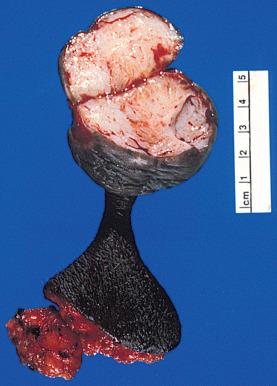
Histologically, fibroepithelial stromal polyps are characterized by the following: (1) superficial location; (2) stellate and multinucleate stromal cells, which tend to be localized at the stromal-epithelial interface and around blood vessels; and (3) a central fibrovascular core ( Fig. 9.2 ). The most varied aspect of these lesions is the stroma, which can range in appearance from hypocellular and bland to hypercellular and pleomorphic. The stroma of polyps that occur during pregnancy tends to exhibit a greater degree of nuclear pleomorphism, cellularity, and mitotic activity, including atypical mitotic figures—hence, the use of the term pseudosarcoma botryoides by some authors. The stromal cells may be positive for desmin, actin, vimentin, estrogen receptor, and progesterone receptor.
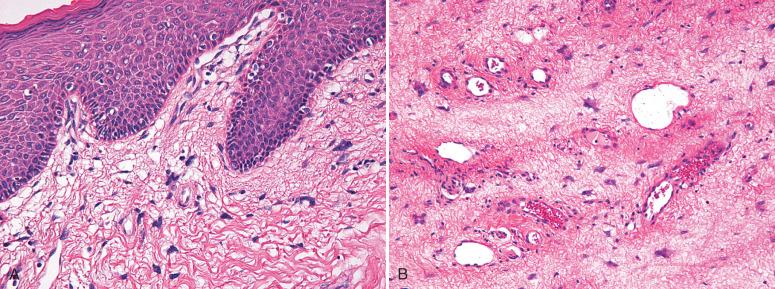
Occasionally, fibroepithelial stromal polyps may undergo torsion, become edematous, and histologically mimic deep (aggressive) angiomyxoma ( Fig. 9.3 ). However, deep (aggressive) angiomyxoma involves deep soft tissue, is infiltrative, is much less commonly polypoid, and exhibits a more prominent vascular component that is diffusely present throughout the tumor as opposed to a central (usually stalk-based) location. Fibroepithelial stromal polyps with hypercellular and pleomorphic stroma may raise the possibility of malignancy ( Fig. 9.4 ). Morphologic clues to the diagnosis of fibroepithelial polyp include the following: (1) lack of a distinct lesional interface with the overlying skin, mucosa, or soft tissue; (2) extension of atypical stromal cells to the stromal–epithelial interface, and (3) the presence of scattered multinucleate stromal cells, usually superficially located (see Fig. 9.2A ).
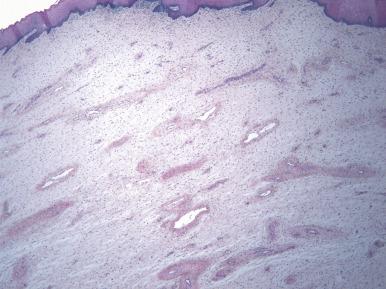
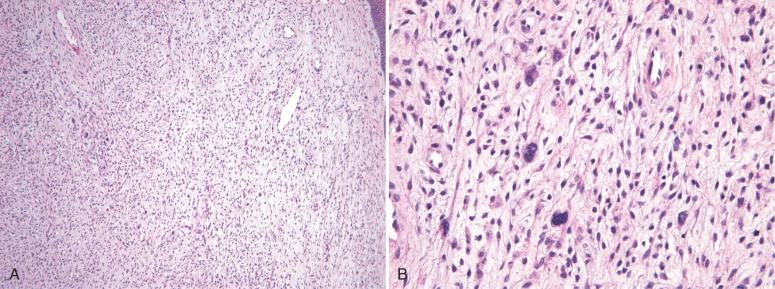
A particularly important differential is embryonal rhabdomyosarcoma. Fortunately, the clinical and histopathologic presentation is straightforward in most cases. Clinically, fibroepithelial stromal polyps rarely occur before puberty, unlike embryonal rhabdomyosarcoma. Histologically, cellular stromal polyps tend to exhibit a greater degree of cellularity in the central portion of the polyp, and the epithelial interface is nondescript, whereas embryonal rhabdomyosarcomas display higher cellularity beneath the epithelium, and the interface with the superficial dermis is distinct (so-called cambium layer). The presence in embryonal rhabdomyosarcoma of strap cells with cross-striations and skeletal muscle marker positivity further aids in this distinction.
A related lesion, genital rhabdomyoma, also has overlapping features: it presents in middle-aged women and is usually polypoid. Nonetheless, rhabdomyoma displays the intracytoplasmic striations characteristic of skeletal muscle and, conversely, lacks thick blood vessels at the tumor base.
An angiomyofibroblastoma is characteristically a well-circumscribed subcutaneous mass rather than a polypoid lesion. In addition, histologically, it has more numerous vessels present diffusely throughout the tumor, which are capillary-sized as opposed to the typically centrally located, larger, thick-walled vessels of stromal polyps. Moreover, the stromal cells of angiomyofibroblastoma usually have an epithelioid appearance, and they typically are clustered around the prominent vasculature.
A superficial angiomyxoma, which has a greater potential to recur locally than fibroepithelial polyp, is characterized by a multinodular growth pattern with a well-defined interface with the surrounding soft tissue, abundant myxoid matrix, numerous neutrophils scattered throughout the tumor and, in approximately one-third of cases, an epithelial component (usually in the form of squamous epithelial lined cysts or basaloid buds, presumably secondary to adnexal entrapment).
Vulvar hypertrophy typically involves the labia minora and can be unilateral; however, unlike a fibroepithelial polyp, growth is not polypoid or mass-forming. Vulvar hypertrophy can morphologically resemble a fibroepithelial polyp because it contains scattered subepithelial atypical spindle and multinucleated cells; moreover, estrogen and progesterone receptor expression has been demonstrated in the stroma, suggesting that like fibroepithelial polyp, labial hypertrophy is related to hormonal stimulation.
Finally, skin acrochordons (skin tags) of nongenital skin are sometimes referred to as fibroepithelial polyps. Fibroepithelial polyps of the female genital tract are best considered separate lesions, given their relationship with sex hormone stimulation and distinct stromal microscopic appearance.
Fibroepithelial stromal polyps are considered benign. Recurrences are infrequent (~15%), particularly if incompletely excised. Multiple stromal polyps may occur during pregnancy, spontaneously regress following delivery, and recur during subsequent pregnancies. This supports the concept that these lesions are hormonally responsive and likely represent a reactive or hyperplastic process involving the distinctive stromal cells of the subepithelial zone of the distal genital tract.
Angiomyofibroblastoma occurs almost exclusively in the vulvovaginal region of reproductive-aged women but has also been described in the fallopian tube and in the inguinal or scrotal region of men. Patients present with a well-circumscribed mass growing over the span of several months before clinical assessment, often thought to represent a Bartholin gland cyst or a lipoma by the clinician.
Macroscopically, angiomyofibroblastomas are well-demarcated lesions with a soft, uniform cut surface. According to a review of reported cases by Sims et al., tumor size ranged from 0.5 to 30 cm (mean, 5.9 cm; median, 4.5 cm).
Histologically, an angiomyofibroblastoma is a well-circumscribed, nonencapsulated neoplasm composed of numerous, uniformly spaced, and delicate thin-walled, capillary-sized vessels and plump stromal cells. The latter, which are typically clustered around the vessels, are set within a variably edematous to collagenous matrix, with alternating zones of cellularity ( Fig. 9.5 ). The stromal tumor cells often have a vague epithelioid appearance, except in postmenopausal patients, in whom they are usually spindled, having moderate amounts of eosinophilic cytoplasm and nuclei, with fine chromatin and inconspicuous nucleoli ( Fig. 9.5B and C ). Likewise, stromal cells may have eccentrically placed nuclei imparting a plasmacytoid appearance, whereas others are multinucleated. There are typically few mitoses. Occasionally, intralesional adipose tissue may be present, and a lipomatous variant has been proposed by some authors ( Fig. 9.5D ). The stromal cells are positive for desmin in 50% to 60% of cases and for actin in 15% of cases, which suggests that angiomyofibroblastomas are tumors with myofibroblastic differentiation. Bcl-2 and CD99 are also frequently expressed. High-mobility group AT-hook 2 (HMGA2) rearrangements and monoallelic loss of FOX01 loci (13q14) have not been identified in vulvovaginal angiomyofibroblastomas.
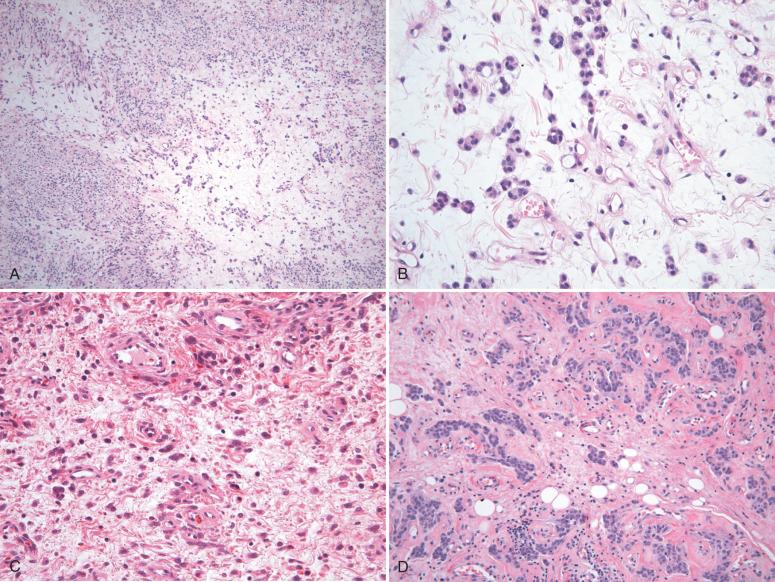
Angiomyofibroblastoma is distinguished from deep (aggressive) angiomyxoma by the presence in the former of a sharply circumscribed margin and plump epithelioid cells clustered around numerous capillary-sized vessels. This is in contrast to deep (aggressive) angiomyxoma, which typically is hypocellular, has an infiltrative margin, and tends to contain larger, thicker walled vessels. Because these tumors share a similar immunophenotype, recognition is based on these morphologic differences.
A fibroepithelial stromal polyp may sometimes fall into the differential diagnosis of angiomyofibroblastoma because both have a prominent vascular component. However, the former more typically presents as a polypoid rather than a subcutaneous mass and has an ill-defined as opposed to a well-circumscribed margin, with the lesional spindle cells characteristically extending up to the stromal–epithelial interface.
A cellular angiofibroma is distinguished from an angiomyofibroblastoma by its less prominent vascular component, which is typically composed of medium-sized vessels, often with hyalinized walls in contrast to the delicate capillary network of angiomyofibroblastoma. In addition, a cellular angiofibroma is more uniformly cellular and the spindle cells are often CD34 positive, arranged in short intersecting fascicles. Moreover, retinoblastoma protein (RB) expression in cellular angiofibroma is deficient, with loss of nuclear staining, because these tumors are associated with a loss of genetic material at RB1/13q14.
A prepubertal vulval fibroma usually occurs at a younger age and is composed of a patternless proliferation of spindle cells, without increased vascularity. In addition, it has an infiltrative margin and is typically positive for CD34 and negative for desmin.
A mammary-type myofibroblastoma lacks the prominent vascular component, alternating zones of cellularity, and perivascular distribution of epithelioid cells characteristic of angiomyofibroblastoma; the spindle cells are positive for CD34 in addition to desmin. Moreover, similar to cellular angiofibroma, RB expression in mammary-type myofibroblastoma is deficient (with loss of nuclear staining) because these tumors are also associated with loss of genetic material at RB1/13q14.
Angiomyofibroblastoma is a benign nonrecurring neoplasm; local excision with clear margins is adequate treatment. The only reported recurrence occurred in a tumor with an area of sarcomatous transformation at the margin, with subsequent local regrowth. A small series of angiomyofibroblastomas with sarcomatous areas has been presented in abstract form, which raised the possibility of a small but existing risk of malignant transformation in these lesions.
Cellular angiofibroma occurs with similar frequency in women (usually in the vulva) and men (usually in the inguinoscrotal region). The mean age at presentation in women is 46 years (range, 20–77 years). Patients usually present with a superficially located painless mass, frequently resembling a Bartholin gland cyst. The lesion is typically small (mean size, 3.6 cm; range, 0.6–12.3 cm).
Macroscopically, cellular angiofibroma is a well-circumscribed, mostly firm lesion with no necrosis. A minority of cases are polypoid, multilobulated, or focally extended into surrounding soft tissue.
Histologically, cellular angiofibroma is a cellular neoplasm composed of uniform, bland spindle cells arranged in short intersecting fascicles, with numerous thick-walled, often hyalinized medium-sized vessels, wispy collagen bundles, and a scant component of mature adipose tissue ( Fig. 9.6 ). The spindle cells typically have ovoid to fusiform basophilic nuclei and scant, pale-staining cytoplasm, with ill-defined borders. Mitoses are typically uncommon. A small subset of cases displays worrisome cytologic features, ranging from scattered severe nuclear atypia to abrupt areas of frank sarcomatous transformation.
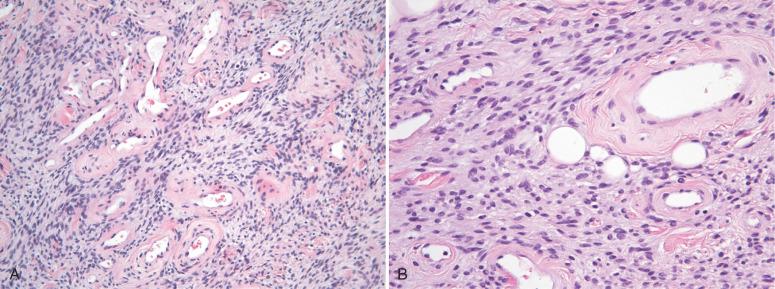
By immunohistochemistry, the stromal cells are usually positive for CD34 (45%–60% of cases); positivity for desmin and smooth muscle actin is less consistent (5%–20% and 8%–15%, respectively), and h-caldesmon is negative. This phenotype suggests that cellular angiofibroma is a neoplasm of fibroblastic, rather than myofibroblastic, origin. Estrogen and progesterone receptors are positive in most cases, also suggesting a role of sex hormones in the pathogenesis of cellular angiofibromas.
In situ hybridization studies have shown a link between cellular angiofibroma and two morphologically similar lesions, spindle cell lipoma and mammary-type myofibroblastoma, by demonstrating common monoallelic deletions of RB1 and FOXO1 at the 13q14 locus. Not surprisingly, RB expression has been shown to be deficient in these tumors with loss of nuclear staining.
Occasionally, cellular angiofibroma may be edematous and mimic deep (aggressive) angiomyxoma; however, the latter is less cellular, more deeply located, more infiltrative, and tends to have larger, thick-walled vessels. In addition, cellular angiofibroma is usually desmin negative (80%–95%) and CD34+ (45%–60%), whereas deep (aggressive) angiomyxoma is typically CD34– and desmin positive and shows intact RB expression.
Angiomyofibroblastoma may also fall into the differential diagnosis because both tumors have a prominent vascular component; angiomyofibroblastoma has more numerous vessels, which are delicate and thin-walled in contrast to the larger, more hyalinized vessels of cellular angiofibroma. Moreover, angiomyofibroblastoma shows alteration in cellularity, imparting a zonal appearance at low-power examination, instead of the more uniform cellularity of cellular angiofibroma. One pitfall occurs when zones of decreased cellularity occur in cellular angiofibroma secondary to edematous change. Although both tumors can be positive for desmin, angiomyofibroblastoma is typically negative for CD34 and has intact RB expression.
Mammary-type myofibroblastoma and cellular angiofibroma share significant morphologic and immunophenotypic overlap because both are well-circumscribed tumors composed of short intersecting fascicles of bland, CD34+ spindle cells within a collagenous stroma. The vascular component of mammary-type myofibroblastoma is typically not as prominent but can show a similar degree of hyalinization. These tumors, along with spindle cell lipoma, are closely related, given their common alterations in the 13q14 locus, and likely represent a morphologic spectrum of varied cellularity and vascularity.
Prepubertal vulval fibroma usually occurs in younger women and is histologically distinguished from cellular angiofibroma by its infiltrative margin, hypocellular appearance, and lack of a fascicular growth pattern.
Cellular angiofibroma is a benign tumor; only one local recurrence has been documented. Conservative local excision is the current recommended treatment. Even cases with a positive resection margin on initial excision seem to have a nil risk of recurrence. Similarly, cases with atypia or sarcomatous transformation appear to behave indolently, with no recurrences reported, although follow-up periods were short in this group.
Initially described in the breast, this entity is widely distributed in extramammary sites, including the inguinal and groin regions, chest wall, trunk, extremities, abdominal cavity, and retroperitoneum. Myofibroblastomas of the lower genital tract have been characterized in two series summing 25 patients, under the terms superficial cervicovaginal myofibroblastoma and superficial myofibroblastoma of the lower female genital tract. The age at presentation has a wide range (23–80 years). A subset of patients has a history of exogenous hormonal or tamoxifen therapy. Most cases occur in the vagina; the cervix and vulva are less common locations.
Macroscopically, female genital myofibroblastomas are well-demarcated polypoid or nodular masses. They are soft to rubbery, with a nodular, whorled, and occasionally myxoid cut surface. Tumor size ranges from 1 to 6.5 cm (mean, 2.7 cm).
Histologically, the tumor is well circumscribed and unencapsulated, with a sharp interface with the superficial dermis (Grenz zone). It is composed of variably sized and haphazardly arranged fascicles of bland spindle to oval cells set within a collagenous matrix that is interspersed with hyalinized collagen bundles, which separate the fascicles. The tumor typically has a component of adipose tissue, the relative proportion of which can vary considerably among tumors ( Fig. 9.7 ). Mitotic activity is sparse and, on occasion, focal cytologic atypia with variations in nuclear size and staining may be present. Myxoid change, multinucleation, and a prominent epithelioid stromal component have been described.

Immunohistochemically, the spindle cells are typically positive for estrogen and progesterone receptors (>95%), desmin (~90%), and CD34 (68%). Smooth muscle actin is usually negative. Like its mammary counterparts, monoallelic loss of FOXO1 on 13q14 has been demonstrated in vaginal myofibroblastoma, with associated loss of RB expression.
Cellular angiofibroma and mammary-type myofibroblastoma appear to be closely related tumors because in addition to showing morphologic and immunophenotypic overlap, they have similar genetic findings with loss of FOX1A1 (13q14). Nevertheless, cellular angiofibroma tends to have a more prominent vascular component and lacks the interspersed hyalinized collagen bundles.
Angiomyofibroblastoma is distinguished from mammary-type myofibroblastoma by its distinctive low-power appearance, with alternation in cellularity, lack of intersecting fascicles, a more prominent vascular component composed of smaller, more delicate capillary-sized vessels, and intact RB but lack of CD34 expression in the stromal cell component.
Prepubertal vulval fibroma occurs at a younger age, is more infiltrative, and is less cellular, with a patternless proliferation of spindle cells.
Deep (aggressive) angiomyxoma typically involves deep soft tissue and is less cellular than mammary-type myofibroblastoma. In addition, it lacks intersecting fascicles of bland spindle cells separated by hyalinized collagen bundles and is more uniformly myxoid, in comparison to examples of mammary-type myofibroblastoma with myxoid change.
Extramammary myofibroblastoma is a benign tumor. Local excision is curative, and no recurrences or metastases have been reported to date.
Prepubertal vulval fibroma, denominated by some as asymmetric labium majus enlargement, is an entity that involves the vulva of premenarchal girls, usually the labium majus. Patients typically present with unilateral, painless, and gradual vulvar enlargement. Although thought to be a lesion exclusively seen in the pediatric population, a case presenting in an adult woman with growth after menopause has also been reported. Although growth is at a slow rate, it can be quite significant, as evidenced in the case of an 18-year-old woman with a 30-cm mass that grew from the size of a pea when first noticed at the age of 11 years.
Lesions are characteristically submucosal or subcutaneous. They range in size from 1.5 to 8 cm (median, 4 cm, except for the case mentioned above). Grossly, the lesion is ill defined, and most tumors described extended to the resection margin. The cut surface is tannish-gray and may have a myxoid appearance.
Histologically, prepubertal vulvar fibroma has ill-defined margins, with no clear interface with the surrounding soft tissue or overlying epithelium. The lesion is composed of a hypocellular proliferation of bland spindle cells, with ovoid nuclei and pale amphophilic cytoplasm arranged in a patternless pattern and set within a variably myxoid, edematous to collagenous matrix ( Fig. 9.8 ). The spindle cells typically infiltrate into surrounding fibroadipose tissue and around nerve bundles and adnexal structures (see Fig. 9.8A ). Small to medium-sized vessels, some with thickened walls, are interspersed throughout the lesion. Mitotic activity is uncommon and nuclear pleomorphism absent.
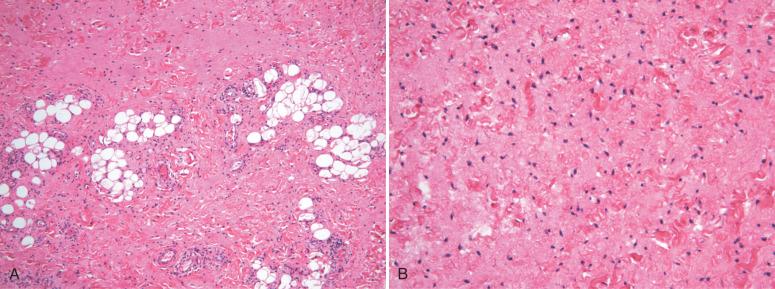
The spindle cells are typically positive for CD34 and negative for desmin, smooth muscle actin, and S100 protein. Estrogen receptor is consistently positive; progesterone receptor expression is variable.
The principal differential diagnostic consideration is deep (aggressive) angiomyxoma because both of these are hypocellular lesions with ill-defined margins. Deep (aggressive) angiomyxoma occurs in older women and is more homogeneously myxoid. In addition, the vascular component is more uniformly distributed and composed of larger, thick-walled vessels. Moreover, neoplastic cells in aggressive angiomyxoma are typically CD34–. Cellular angiofibroma mostly occurs in older women, is typically well circumscribed and more cellular, has a more prominent vascular component, and shows loss of RB expression. Angiomyofibroblastoma also occurs in older women, is well circumscribed, shows alternating zones of cellularity, and contains epithelioid cells clustered around a prominent vascular network.
The nature of prepubertal vulvar fibroma is uncertain. It has been proposed that these lesions represent an abnormal response of the hormonally responsive vulval mesenchyme to changes in the hormonal milieu during puberty, resulting in asymmetric enlargement of the labium majus. However, others have considered this lesion as neoplastic in nature, given the fact that most are unilateral, form a mass, and have the potential to recur. Prepubertal vulval fibroma appears to be benign, although it may recur if incompletely excised. Only a limited number of cases have been described, and there is controversy over whether this represents a true neoplasm, so conservative excision appears appropriate.
Deep (aggressive) angiomyxoma is a locally infiltrative neoplasm that occurs in the female pelvis and perineum, as well as analogous sites in men. In women, the median age at presentation is typically in the fourth decade. Similar to other soft tissue tumors that occur at this site, aggressive angiomyxoma is often mistaken for a labial cyst, usually a Bartholin gland cyst. Tumors can be of varying size but are often relatively large (>10 cm), with distortion of normal anatomy. Imaging studies are often quite helpful in assessing extent of disease and for surgical planning because tumors may be larger than appreciated on clinical examination alone ( Fig. 9.9 ).

Aggressive angiomyxoma typically has a gelatinous appearance on gross examination but may appear more fibrous, a feature mainly seen in recurrent cases ( Fig. 9.10 ). Histologically, the tumor is paucicellular, with deceptively infiltrative borders, which accounts for its propensity to recur. Bland spindle-shaped cells with delicate unipolar or bipolar cytoplasmic processes are set within a myxoid stroma with interspersed medium to large-sized vessels, which are often thick walled and hyalinized ( Fig. 9.11 ). Loose fibrillar collagen and collections of smooth muscle cells (so-called myoid bundles) are typically arranged in loose clusters or tight whorls adjacent to blood vessels ( Fig. 9.12 ). The lesional stromal cells of aggressive angiomyxoma are positive for estrogen receptor (87%–100%), desmin (72%–92%), and smooth muscle actin (90%), particularly in the myoid bundles. In addition, the spindle cells can be positive for CD34 (45%), HMGA2 (37%–83%) , and CDK4 (62%–100%). The expression of the latter two markers is related to structural rearrangements of the region 12q15. Alteration of the HMGA2 locus is the most common chromosomal aberration observed in aggressive angiomyxoma, occurring in approximately 30% of cases. The break involving the 12q15 region may be intragenic or extragenic—inside or outside the HMGA2 gene, respectively. HMGA2 expression by immunohistochemistry has been shown to be highly sensitive for aggressive angiomyxoma in one study ; however, specificity is lower because the marker was also positive in a subset of leiomyoma (43%) of leiomyomas and a minority of fibroepithelial polyps and angiomyofibroblastomas. Moreover, it does not necessarily correlate with gene rearrangement. This test, nonetheless, may be useful in confirming the diagnosis or assessing margin status.
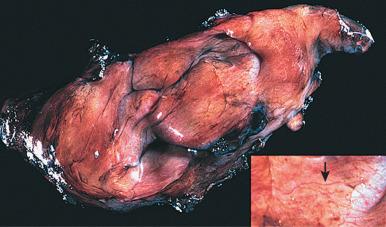
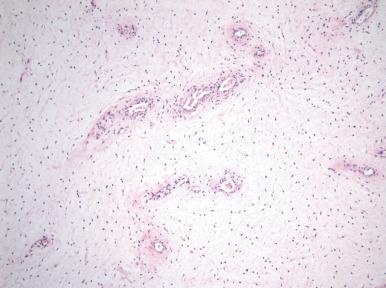
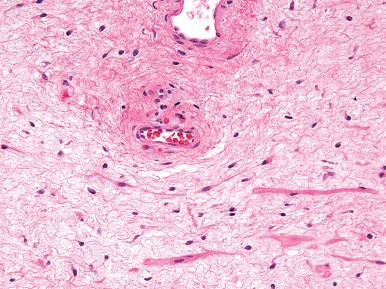
The entities that usually fall into the differential diagnosis of aggressive angiomyxoma include angiomyofibroblastoma, fibroepithelial stromal polyp, and superficial angiomyxoma; the two former lesions and their distinction from aggressive angiomyxoma have been discussed in the previous sections. Although usually encountered outside the vulvovaginal region, superficial angiomyxoma can occur in this area and may be mistaken for aggressive angiomyxoma. Superficial angiomyxoma differs from deep (aggressive) angiomyxoma in its tendency to be centered in the dermis and subcutis and by its lobulated growth pattern. In addition, the lesional stromal cells of superficial angiomyxoma are desmin negative. Rarely, massive vulval edema secondary to obesity and immobilization can mimic aggressive angiomyxoma. It is distinguished by its bilaterality, clinical presentation, lack of myxoid stroma, and presence of perivascular lymphoid infiltrates.
Aggressive angiomyxoma has a propensity for local destructive recurrence, which occurs in 30% to 40% of cases, particularly if the tumor is incompletely excised. Recurrence may manifest many years (often decades) after the initial excision. Distant metastases and death due to aggressive angiomyxoma are exceedingly rare; two cases with such an outcome have been reported. Wide excision with clear margins of at least 1 cm should be attempted if this entity is suspected; however, given its deceptively infiltrative nature, complete resection is not always achieved. As with other vulvar mesenchymal tumors, the consistent hormone receptor expression and the documentation of rapid growth during pregnancy suggest a role of estrogen stimulation in the pathogenesis. Furthermore, it suggests that aggressive angiomyxoma may be responsive to gonadotropin-releasing hormone (GnRH) agonists, as has been reported in one case. This alternative can be considered in cases with positive margins or those deemed unresectable.
The head and neck region and trunk are the most common sites for superficial angiomyxoma; however, it may also occasionally occur in the genital region. It usually occurs in the fourth decade, typically as a slow-growing, painless, polypoid tumor clinically interpreted as an acrochordon or vulvar cyst. The presence of multiple cutaneous myxomas and angiomyxomas that occur at certain sites, such as the external ear or breast, is highly associated with Carney's complex; this association is less clear with superficial angiomyxoma occurring in the genital area.
The gross appearance is of a nodular or multilobulated lesion, with a gelatinous cut surface. The tumor is usually less than 5 cm, with rare cases being as large as 12.5 cm. Histologically, superficial angiomyxoma is characteristically multilobulated and superficially located in the dermis and subcutis, with a well-demarcated border ( Fig. 9.13 ). The myxoid nodules are composed of slender spindle- and stellate-shaped cells, inflammatory cells (particularly polymorphonuclear leukocytes), and thin-walled vessels ( Fig. 9.14 ). An epithelial component, presumably entrapped adnexal structures seen in the form of squamous epithelial-lined cysts or basaloid nests and strands, is present in approximately 30% of cases ( Fig. 9.15 ). By immunohistochemistry, stromal cells are positive for CD34 but lack desmin, estrogen receptor, and progesterone receptor expression, which contrasts with most other genital mesenchymal tumors discussed previously in this chapter.
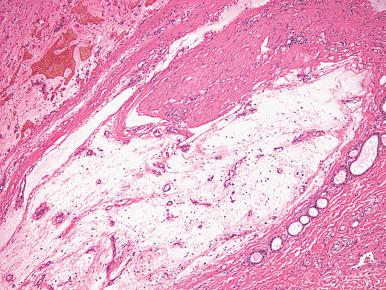
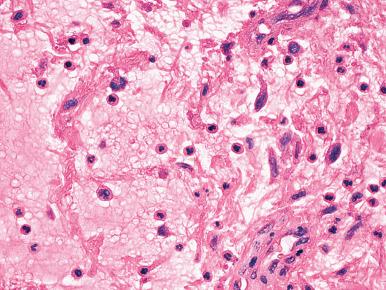
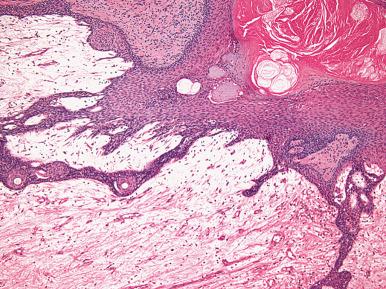
The bland stromal cell morphology and abundant myxoid stroma of superficial angiomyxoma overlap with the appearance of deep (aggressive) angiomyxoma. Unlike aggressive angiomyxoma, which is a deep-seated tumor usually larger than 10 cm, a superficial angiomyxoma is small (<5 cm) and involves the dermis and subcutis. Furthermore, superficial angiomyxoma contains neutrophilic infiltrates and lacks the infiltrative borders and thick-walled vessels of deep (aggressive) angiomyxoma. Immunohistochemistry for desmin, estrogen receptor, and/or progesterone receptor is negative in superficial angiomyxoma and positive in aggressive angiomyxoma.
Superficial angiomyxoma is considered benign; however, the risk for local nondestructive recurrence is approximately 30% to 40%. Thus, complete excision with clear margins is advised.
Dermatofibroma, also known as fibrous histiocytoma (and also called nodular subepidermal fibrosis in the older literature), is a tumor of dermal stroma. This tumor usually occurs in adults on the limbs and trunk area but may also rarely involve the vulva. It can have a range of clinical appearances, presenting as flesh-colored or pigmented plaques, nodules, or papules. Although nonspecific, dermatofibroma can be suspected on clinical examination by the so-called dimple sign—pinching the tumor results in inward dimpling of the epidermis.
Become a Clinical Tree membership for Full access and enjoy Unlimited articles
If you are a member. Log in here